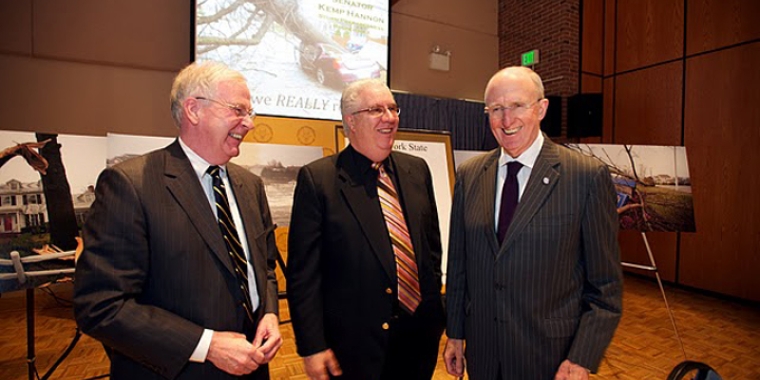
IS LONG ISLAND PREPARED FOR THE NEXT BIG STORM

Senator Carl L. Marcellino (5th SD) , Senator Kemp Hannon (6th SD), Senator Charles J. Fuschillo, Jr. (8th SD), and Assemblyman David G. McDonough (19th AD) joined today with emergency experts, law enforcement officials, transportation experts, first responders and community leaders to determine if Long Island is best prepared for the next big storm or hurricane. During the public roundtable discussion held at Adelphi University, Senator Hannon lead the discussion by questioning the efficiency and effectiveness of response efforts to the March 2010 nor’easter that hammered Long Island.
Senator Marcellino said, “This last storm produced record rainfall, flooding and outages, and our emergency preparedness systems were definitely put to the test, unfortunately we fell short. All levels of government have a role to play to ensure the safety and welfare of all Long Islanders. By being proactive in establishing a clear and effective emergency plan we will be prepared for any future crisis.”
“There’s no debate, some parts of our response efforts during the storm in March are to be commended, while others need to be improved upon,” said Senator Hannon. “A lack of phones at the Nassau County 911 emergency center proved to be a problem this time around, but what’s it going to be next time? We need to look at all aspects of our communication, evacuation, sheltering and utility response plans now, if we are going to keep everyone safe, informed and get them back to their normal routines as soon as possible. We need certainties, not probabilities. We need practical solutions, not plausible suggestions,” Hannon continued.
Nassau County’s emergency 911 system was overloaded with calls that it could not handle. Nassau County has 19 phones in its 911 system while Suffolk has 40. Nassau County Executive Ed Mangano has since pledged to spend roughly $7 million to upgrade the 911 system. It was recently reported that the Suffolk 911 system encountered problems as well, with over 2,000 calls not getting through to a 911 operator during the storm.
Despite the March nor’easter lacking the force of a Hurricane, well over 250,000 Long Islanders lost power. The nor’easter hit the Island on Saturday, March 13. As of Wednesday March 17 at 7:30 p.m., over 9,000 Long Islanders remained without power. LIPA maintains it completed restoration ahead of neighboring utilities that sustained similar damage.
“We certainly welcome the opportunity to sit down with our State and local agencies, first responders and emergency experts to explore ways we can better prepare for major storms and fine tune our communication efforts to our customers and government officials,” said LIPA President and CEO Kevin S. Law. “This nor’easter was one of the biggest storms to hit Long Island in 20 years and while we were pleased with the overall restoration efforts, we realize that there is always room for improvement.”
According to a LIPA report released on March 25, on Saturday March 13 at 6 p.m. there was a call placed to the New York Mutual Assistance Group, but no crews were requested or released based on weather conditions. At 8 p.m. a request for assistance was sent to National Grid, New York and New England contractors. At 4 a.m. on Sunday March 14, National Grid contractors were on the road from Albany to Long Island, and at 5 a.m. National Grid crews left Syracuse for Long Island. At 7:30 a.m. LIPA requested off-Long Island line and tree crews, and at 9 a.m. they participated in the New England Mutual Assistance Group phone call, where they requested additional crews.
Senator Fuschillo said, “The recent nor’easter caused extensive damage and left thousands of Long Islanders without power for days; a hurricane would be far more devastating. Being fully prepared is the best way to protect people’s lives and homes and quickly recover from storm damages. Reviewing the recent storm response to find out what worked well and where improvements are needed will help make sure that Long Island is better prepared in the future.”
Assemblyman McDonough said, “While Long Island is blessed with beautiful coastal waters, beaches and natural beauty, we do remain exposed to the unpredictable forces of nature—potentially endangering our loved ones and property. No one can prevent natural emergencies, but we can take steps to protect our families and ourselves. Knowing how to respond to natural emergencies, including hurricanes, floods, snowstorms and fires, can prevent injuries and minimize property damage.”
Commissioner of the Office of Emergency Management, James J. Callahan III said, “I commend Nassau County Executive Ed Mangano for taking immediate action to invest $7 million to expand our 911 call center to prevent any future problems. The County Executive is committed to ensuring the safety of our residents. Today’s roundtable is a good step toward better preparing Long Island for future emergencies.”
Nassau County Police Chief of Department, Karen O’Callaghan said, “The Nassau County 911 system currently exceeds the industry standard with 95 percent of calls being answered within 10 seconds or less. However, the severity of the March storm was underestimated by everyone and it did reveal some need for improvement. The inefficiencies that were pointed out emphasized the need for the new state of the art communications bureau that was recently announced by Nassau County Executive Ed Mangano.”
In addition to discussing the utility company’s response efforts, the roundtable panelists discussed in detail Long Island’s current communication, evacuation and sheltering plans, and questioned the ability to amend the plans in accordance with evolving infrastructure and transportation routes. Panelists also highlighted Nassau County’s emergency notification system and the use of a Catastrophe fund to help New Yorkers rebuild as quickly as possible in the aftermath of a catastrophe.
Other experts invited to take part in the panel discussion included Senior VP of Operations of LIPA - Mike Hervey, Director of State Emergency Management Office - John R. Gibb, CEO of Nassau County Red Cross - Frank Cassano, Regional Emergency Manager of NYS Department Of Transportation - Emilio Sosa, Regional Transportation Maintenance Engineer of the NYS Department of Transportation - Richard Causin, and a representative of the Uniondale School District – Christine Lopes.
1985 became a turning point for community response officials when Hurricane Gloria hit Long Island with sustained wind gusts of 115 mph. The damage caused by Gloria was extensive, including: massive flooding, coastal erosion, and damage to residential and commercial structures, utility lines, roads and other infrastructure. Well over 400,000 Long Island Lighting Company customers were left without power.
Twenty-five years later, Long Islanders still find themselves in a similar predicament, dealing with lasting power outages, major flooding and erosion concerns.
According to the State Emergency Management Office, hurricane season on Long Island is from June until to November.



